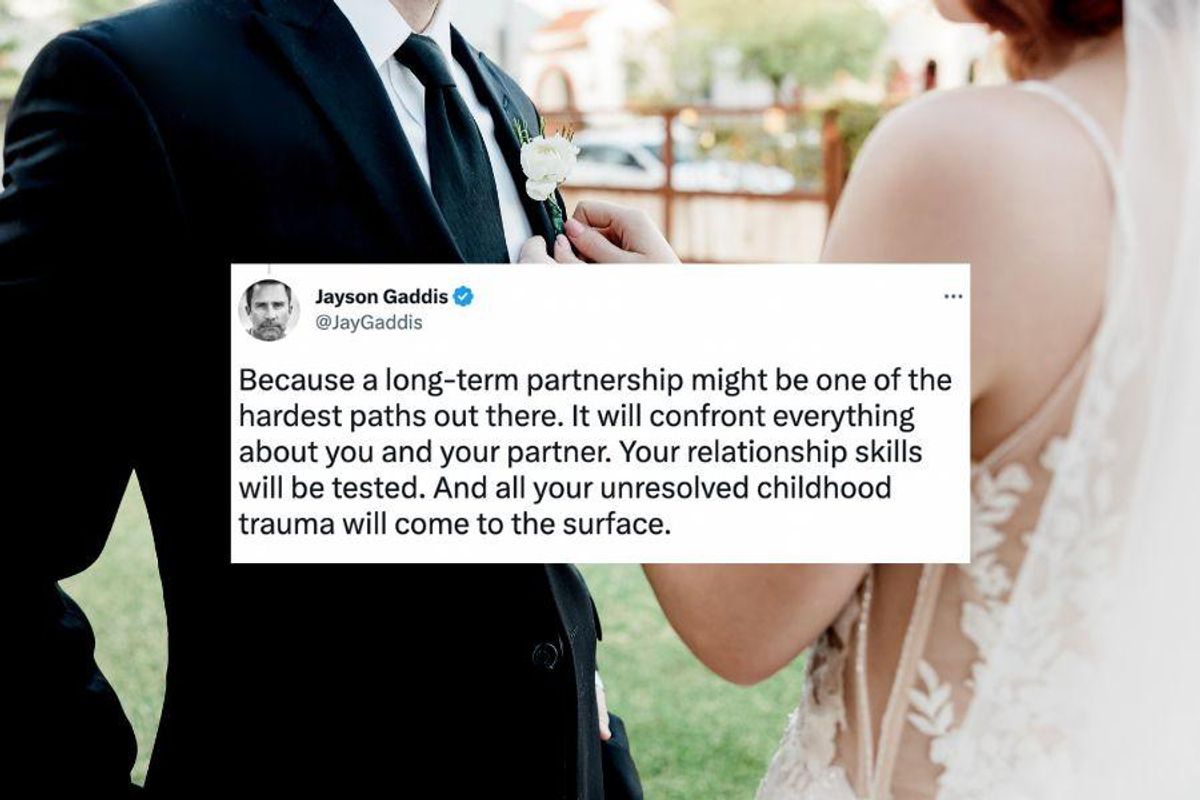Relationship expert tells people to never get married unless you're willing to do 3 things
"If you and your partner (both) are unable or unwilling to do these 3 things consistently forever, you won’t make it."

Relationship expert gives people advice on getting married.
Being in a relationship can be difficult at times. Learning someone else's quirks, boundaries, and deep views on the world can be eye-opening and hard. But usually, the happy chemicals released in our brain when we love someone can cause us to overlook things in order to keep the peace.
Jayson Gaddis, a relationship expert, took to Twitter to rip off people's rose-colored glasses and tell them to forego marriage. Honestly, with the divorce rate in this country being as high as it is, he probably could've stopped his tweet right there. Don't get married, the end. Many people would've probably related and not questioned the bold statement, but thankfully he followed up with three things you must be willing to do before going to the chapel.
Before going into his reasons for why he tells people not to get married, Gaddis explained that he is a person that "LOVEs being married." I mean, it would probably make him a pretty weird relationship expert if he hated relationships, so it's probably a good thing he enjoys being married. Surely his spouse appreciates his stance as well.
So why does he tell unsuspecting people not to get married? "Because a long-term partnership might be one of the hardest paths out there. It will confront everything about you and your partner. Your relationship skills will be tested. And all your unresolved childhood trauma will come to the surface," Gaddis wrote.
Unresolved childhood trauma can become a major problem in relationships because oftentimes our trauma is present in how we react to conflict or relationship strain. According to Kaytee Gillis, LCSW-BACS, childhood trauma manifests in relationships in multiple ways including fear of abandonment, being easily irritated, constantly arguing or avoiding conflict at all costs.
\u201cNever, ever get married. Unless you are willing to do these 3 things.\u201d— Jayson Gaddis (@Jayson Gaddis) 1675182104
It's not unwise to tuck that bit of information in your pocket if you're thinking about a long-term relationship, and Gaddis bringing this to the forefront will certainly benefit someone. That's not to say you can't be in a relationship if you have trauma; Gaddis is simply suggesting that you be aware of your traumas and how they may show up in the course of a relationship.
He then went on to get into his actual list of things couples should be willing to do before they get married in order to have a successful marriage.
"Learn. Learn about you, learn about them. Never stop learning about yourself and each other in the context of your relationship," he wrote, which falls right in line with his pre-numbered suggestions.
Now, the second suggestion may have people quickly raising an eyebrow, especially if they don't like conflict. Gaddis suggested embracing "conflict, adversity and challenges" and getting "very very good at repairing it and working it through 100% of the time."
\u201cSomething about long-term partnership invites us to face everything unloved and unprocessed in our psychology, neurobiology, and mammalian wiring. It is, at its core, a spiritual path.\u201d— Jayson Gaddis (@Jayson Gaddis) 1675182104
That's a good one. Conflict resolution is a skill and committing to sharpening it and using it every single time could save some relationships. The third may help preemptively alleviate some unforeseen power struggles and I'm here for it.
"Share leadership and collaborate. Being teammates about everything and sharing the load together is crucial. Be honest about how hard it is to share leadership and get better at it," Gaddis tweeted before elaborating further in the thread.
The author and relationship expert bluntly stated that if both people can't agree to do those three suggestions, then the couple would not survive. Gaddis rounded out the Twitter thread by explaining that unless you're ready to work on yourself and commit to the three things listed, you should stay single.
Ouch. Harsh words, but it's better to come from a behavior and relationship expert than anyone else.
This article originally appeared on 2.3.23
- 7 things we can learn about love from prehistoric humans. ›
- 11 emotional, hilarious, and moving photos from the Museum of Broken Relationships. ›
- Why do people stay in abusive relationships? This heartbreaking analogy helps explain. ›
- Man shares the premarital counseling he wishes he'd had - Upworthy ›
- Men share the secrets they keep from their spouses - Upworthy ›





 Vincent Van Gogh's Self-Portrait, 1889Image via
Vincent Van Gogh's Self-Portrait, 1889Image via  Turbulent flow illustrated and animated.
Turbulent flow illustrated and animated. Animation of art referencing science.
Animation of art referencing science. Animated Starry Night
Animated Starry Night An animated depiction of The Scream.
An animated depiction of The Scream. People clinking their glasses of red wine for a cheers.
Photo by
People clinking their glasses of red wine for a cheers.
Photo by  I Love You Elf GIF by MOODMAN
I Love You Elf GIF by MOODMAN "Love you!" Oops.
"Love you!" Oops. Green Flag GIF by The Last Talk Show
Green Flag GIF by The Last Talk Show Embarrassed Hide GIF by flor
Embarrassed Hide GIF by flor gorilla hurrying GIF
gorilla hurrying GIF Gorillas are generally pretty chill.
Gorillas are generally pretty chill. A court reporter taking notes.via
A court reporter taking notes.via Depiction of Jesus Christ in Heaven.via
Depiction of Jesus Christ in Heaven.via A photo of Santa Claus.via
A photo of Santa Claus.via